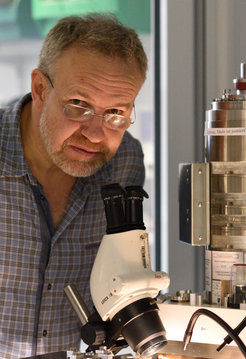Deep insights into the brain: Zülch Prize 2015
Winfried Denk develops new microscopy methods, thereby revolutionizing neuroscience
Anyone who wants to understand the brain must be able to see the brain's microscopically small switching units – the neurons – at work. Conventional light microscopes are not sufficient to do the job. Only the microscopes developed by Winfried Denk and his colleagues display the structure of neurons and their changes in the intact brain. Consequently, neuroscientists can now observe neurons in the living brain and generate three-dimensional images of nerve tissue, including all its synaptic connections. For this pioneering work, Winfried Denk will receive the Zülch Prize, worth 50,000 euros. The prize will be awarded on 4 September 2015 in Cologne.

Everything started with the light microscope: simple glass lenses and simple sunlight were enough for the researchers living in the 17th century to be able to observe cells for the first time. Now, even school students work with light microscopes in their biology class when they want to observe cells. However, scientists quickly reach their limits with light microscopes: neurons often appear blurred, for example, as the surrounding nerve tissue scatters the light too strongly in the microscope, and details remain hidden. Furthermore, cell activity cannot be visualized with light microscopes.
In contrast, researchers can use the two-photon fluorescence microscope, developed by Winfried Denk with Jim Strickler and Watt Webb at Cornell University in the USA in the late 1980s, to examine neurons with hitherto unrivalled clarity. But that's not all: with a two-photon microscope they can even observe cells in the living brain over long periods of time. Another advantage is that the light penetrates deep into the tissue and also renders cells visible that are up to one millimetre below the surface. That is roughly 20-times deeper than a conventional light microscope can penetrate nerve tissue.
In the meantime, neuroscientists around the world are researching how neurons work using two-photon microscopes. Much of the information about the brain that has been discovered in recent years would not have been possible without the technology – a development that could not be foreseen at the birth of the two-photon microscope 25 years ago.
Two-photon microscopy is a more developed form of fluorescence microscopy. Conventional fluorescence microscopes use short-wave blue or ultraviolet light and thus excite dyes in the cell to become illuminated. The cell then becomes visible to the observer. At the same time, however, the energy-rich light also damages the cell. In two-photon fluorescence microscopy, on the other hand, low-energy red or infrared laser light is used. On their own, light particles (photons) with this wavelength do not have enough energy to excite the dye. If, however, two photons meet simultaneously on a molecule of dye, their energy is added together and illuminates the dye. Researchers can thereby analyze the little tree-like projections from neurons and their synapses. Dyes that are excited only in active neurons to become illuminated can also tell scientists when and how strongly a cell is electrically active.
But Winfried Denk is not just interested in individual neurons and their activity - he would also like to understand the links between the cells. His aim is to create a complete wiring diagram of a mouse's brain – a connectome. To do this, he developed the serial block-face scanning electron microscope around 10 years ago. Unlike the two-photon microscope, it illuminates the tissue with an electron beam rather than light. This means that the serial block-face scanning electron microscope can display even smaller details, but not in living tissue.
The specimen is first prepared in a special procedure and then scanned by an electron beam. An automated cutter then removes a layer of tissue, just a few millionth of a millimetre thick, for the next image. From the two-dimensional images of the individual levels, the researchers can compile a three-dimensional image on the computer.
Denk thus succeeded in automating the painstaking and error-prone production of serial sections. Using this method, he and his colleagues have already analyzed circuits from the retina of a mouse's eye. In a cube of retina alone, which measured one-tenth of a millimetre along one side, the scientists discovered almost 1,000 neurons with around half a million connections. In light of these figures, it can be easily imagined how complex the connectome of the mouse brain – 200,000 times bigger – is. It is only with such a wiring diagram that scientists can decode the functioning of the brain and better understand diseases of the nervous system.
Winfried Denk was born in Munich and studied physics and biophysics in Munich at Ludwig-Maximilians-Universität and in Zurich (Switzerland) at the Eidgenössische Technische Hochschule (ETH). He did his doctorate at Cornell University in the USA in Watt W. Webb's laboratory. Following a brief period at the IBM research lab in Rueschlikon (Switzerland) he worked for several years at Bell Laboratories in New Jersey. In 1999, he returned to Germany and was appointed Director at the Max Planck Institute for Medical Research in Heidelberg. He has been an honorary professor at the University of Heidelberg since 2002. He is now Director of the Electrons – Photons – Neurons Department at the Max Planck Institute of Neurobiology in Martinsried.
The K. J. Zülch Prize 2015 will be presented on 4 September between 10:00 a.m. and midday in the Hansasaal of Cologne's historic City Hall. Following a speech by Bert Sakmann from the Max Planck Institute of Neurobiology in Martinsried, Winfried Denk will then report on the methods that can be used to map and decode the circuits of the brain.
CS/HR












